
How to Make a Hospital Bed More Comfortable
Learning how to make a hospital bed more comfortable involves several practical modifications including upgrading the mattress, adding specialized toppers, using positioning features, incorporating high-quality bedding, and adding comfort accessories like padded rail covers.
These strategic enhancements can transform a clinical bed into a comfortable healing environment, improving sleep quality and overall patient well-being during extended periods of bed rest.
Key Takeaways:
- Quality mattresses and toppers significantly enhance hospital bed comfort
- Proper positioning through electric adjustability reduces pressure and improves sleep
- Specialized bedding and pillows designed for medical beds prevent discomfort
- Accessories like overbed tables and rail pads improve functionality and comfort
- Temperature regulation products help maintain optimal sleeping conditions
- Regular repositioning schedules prevent pressure points and discomfort
Why Hospital Bed Comfort Matters
Hospital beds serve vital medical functions, but comfort shouldn't be sacrificed for clinical utility. Understanding how to make a hospital bed more comfortable begins with recognizing that enhanced comfort delivers significant benefits:
- Improved Sleep Quality - Better sleep accelerates healing and improves mood
- Reduced Pain - Proper support and positioning minimize discomfort
- Decreased Pressure Injury Risk - Comfort enhancements often reduce pressure points
- Enhanced Psychological Well-being - Comfort creates a more positive recovery environment
- Increased Independence - Comfortable patients tend to be more mobile and self-sufficient
For those using hospital beds at home, comfort becomes even more critical as these beds often serve as both medical equipment and primary sleeping surface for extended periods.
Let's explore effective strategies for transforming a clinical hospital bed into a comfortable, supportive healing environment.
Selecting the Right Hospital Bed for Comfort
The foundation of comfort begins with choosing the right bed:
Key Features for Comfort in Hospital Beds
When selecting from electric hospital beds for home use, prioritize these comfort-enhancing features:
- Full Electric Functionality - Electric adjustment of head, foot, and height positions
- Smooth, Quiet Operation - Motors that won't disturb sleep during adjustments
- Proper Sizing - Adequate width and length for the patient's height and build
- Quality Frame Construction - Sturdy, stable base that minimizes movement and noise
- Compatibility with Accessories - Ability to accommodate specialized comfort enhancements
The best fully electric hospital beds for home use offer optimal comfort through multiple position adjustments that can be modified throughout the day as needs change.
Electric Hospital Beds
Essential Mattress Upgrades for Hospital Beds
The mattress is the single most important comfort element in any bed setup:
Specialized Hospital Bed Mattresses
Standard hospital mattresses often prioritize durability and cleaning ease over comfort. Upgrading to specialized hospital bed mattresses can dramatically improve comfort:
-
Memory Foam Hospital Mattresses
- Conform to body contours for pressure relief
- Provide superior weight distribution
- Reduce motion transfer during repositioning
- Available in various thicknesses and densities
-
Gel-Infused Foam Mattresses
- Combine support with temperature regulation
- Disperse heat away from the body
- Provide pressure point relief
- Offer improved breathability over standard foam
-
Hybrid Hospital Mattresses
- Combine innerspring support with foam comfort layers
- Provide enhanced edge support for safer transfers
- Offer balanced support for different body types
- Typically provide better airflow for cooling
When selecting a mattress replacement, ensure it's designed specifically for articulating hospital beds to prevent bunching or shifting during position changes.
Mattress Toppers for Enhanced Comfort
For patients who cannot replace their existing mattress, toppers offer a cost-effective comfort solution:
- Pressure-Relief Gel Toppers - Distribute weight evenly while cooling
- Egg Crate Foam Overlays - Improve air circulation and reduce pressure points
- Sheepskin Overlays - Provide natural pressure relief and temperature regulation
- Air-Filled Toppers - Allow customizable firmness for individual comfort
These toppers can significantly enhance comfort while maintaining the functionality of the original hospital mattress.
Positioning Strategies for Comfort Enhancement
Proper positioning is central to how to make a hospital bed more comfortable:
Leveraging Electric Adjustability
Electric beds for elderly patients offer positioning options that dramatically improve comfort:
-
Semi-Fowler Position (30° head elevation, slight knee elevation)
- Reduces respiratory effort
- Minimizes acid reflux
- Enhances conversation and activities
- Improves circulation in lower extremities
-
Zero-Gravity Position (head and knees elevated to specific angles)
- Mimics weightlessness for pressure relief
- Reduces strain on the heart
- Minimizes lower back pressure
- Improves circulation throughout the body
-
Contour Position (slight elevation of all sections)
- Follows natural body curves
- Reduces pressure on joints
- Prevents sliding down in bed
- Distributes weight across the entire body
For those using specialized bariatric hospital beds, proper positioning becomes even more crucial for comfort and preventing skin breakdown.
Hospital Bed Mattress
Strategic Pillow Placement
Beyond the bed's positioning capabilities, strategic pillow placement enhances comfort:
-
Head and Neck Support
- Cervical pillows maintain proper spinal alignment
- Multiple height options accommodate different sleeping positions
- Proper support reduces neck pain and headaches
-
Body Alignment Pillows
- Wedge pillows support specific body areas
- Body pillows prevent rolling and provide side support
- Lumbar pillows maintain lower back curves when sitting up
-
Extremity Support
- Heel and elbow pillows prevent pressure ulcers
- Leg elevation pillows reduce swelling
- Arm support pillows relieve shoulder strain
These positioning aids complement the bed's features while adding customized comfort for individual needs.
Specialized Bedding Solutions
The right bedding dramatically improves hospital bed comfort:
Hospital Bed Sheets and Linens
Standard sheets often fit poorly on hospital beds, especially during position changes. Consider:
- Fitted Sheets with Deep Pockets - Accommodate mattress height plus any toppers
- Knit Sheets with Extra Stretch - Flex during articulation without coming loose
- Quick-Change Bedding Systems - Allow linen changes without completely moving the patient
- Moisture-Wicking Fabrics - Enhance comfort for patients who perspire heavily
Luxury hospital beds for home environments benefit particularly from high-quality linens that combine functionality with aesthetic appeal.
Temperature Regulation Bedding
Maintaining optimal sleeping temperature significantly impacts comfort:
- Cooling Gel Sheet Sets - Draw heat away from the body
- Moisture-Wicking Mattress Protectors - Keep skin dry while protecting the mattress
- Weighted Blankets with Cooling Technology - Provide comforting pressure without overheating
- Temperature-Regulating Comforters - Adjust to body temperature changes throughout the night
These specialized bedding options can transform the hospital bed experience, creating a microclimate that supports restful sleep and healing.
Comfort-Enhancing Accessories
Beyond the bed itself, numerous accessories improve comfort and functionality:
Side Rail Comfort Enhancements
Hospital bed rails are necessary for safety but can create uncomfortable barriers:
- Padded Rail Covers - Soften hard surfaces and prevent skin contact with cold metal
- Rail Pouches and Organizers - Keep essentials within easy reach
- Gap Fillers - Prevent limbs from becoming caught between rails and mattress
- Custom-Fit Bumpers - Protect from accidental bumps while providing a softer visual appearance
These enhancements maintain safety while significantly improving comfort.
Overbed Tables and Positioning Aids
Functional accessories that improve daily living in a hospital bed include:
- Adjustable Overbed Tables - Support meals, activities, and laptop use at ideal heights
- Bed Wedges and Backrests - Provide additional positioning options beyond the bed's capabilities
- Reading and Tablet Holders - Reduce neck strain during leisure activities
- Swing-Away Trays - Offer convenient surfaces without restricting movement
These practical additions support independence and comfort during extended bed rest.
Creating an Optimal Bedroom Environment
The surrounding environment significantly impacts how comfortable a hospital bed feels:
Room Layout Considerations
When incorporating a hospital bed for sale into a home environment, consider:
- Strategic Bed Placement - Position to maximize natural light and window views
- Accessibility Planning - Ensure adequate space around all sides for caregivers
- Privacy Solutions - Use room dividers or curtains when bed must be in shared spaces
- Technology Integration - Arrange entertainment and communication devices within easy reach
These environmental factors contribute significantly to the overall comfort experience.
Luxury Hospital Bed for Home
Lighting and Sound Management
Sensory elements dramatically affect comfort and sleep quality:
- Adjustable Lighting - Layered options from bright task lighting to subtle night lighting
- Sound Machines - Mask disruptive environmental noises
- Room-Darkening Window Treatments - Support healthy sleep cycles
- Acoustic Improvements - Reduce echo and noise that can make clinical equipment more noticeable
Creating a soothing sensory environment helps the hospital bed feel less institutional and more like a comfortable retreat.
Maintenance Practices That Enhance Comfort
Regular maintenance ensures lasting comfort:
Keeping the Bed in Optimal Condition
Proper hospital bed cleaning and maintenance directly impact comfort:
- Regular Mattress Rotation - Prevents uneven wear and compression
- Prompt Stain Treatment - Maintains hygiene and prevents discomfort from dried spills
- Mechanical Lubrication - Ensures smooth, quiet operation during position changes
- Connection Checks - Prevents disruptions from loose cords or controllers
These maintenance practices preserve comfort features and extend the bed's useful life.
Establishing Comfort-Focused Care Routines
Daily care routines should prioritize comfort:
- Regular Repositioning Schedules - Prevent pressure points and stiffness
- Consistent Linen Changes - Maintain freshness and hygiene
- Morning and Evening Comfort Assessments - Proactively address discomfort
- Bedtime Preparation Routines - Create optimal sleeping conditions
These routines ensure that comfort remains a priority throughout care delivery.
Specialized Comfort Solutions for Medical Conditions
Different conditions require specific comfort approaches:
Pain Management Adaptations
For patients with chronic pain, consider:
- Vibration and Massage Features - Some advanced beds or add-on systems provide gentle relief
- Zoned Support Systems - Target support to painful areas while softening others
- Heat Therapy Integration - Safe warming elements that relieve muscle tension
- Adjustable Firmness Options - Customizable support for changing pain levels
When selecting from quality hospital bed brands, look for those with features specifically designed for pain management.
Respiratory Comfort Enhancements
For patients with breathing difficulties:
- Programmable Elevation Presets - Save optimal positions for respiratory ease
- Customized Support Wedges - Maintain specific angles that maximize lung expansion
- Adjustable Upper Body Support - Accommodate changes in respiratory status throughout the day
- Integrated Headboard Accessories - Support oxygen equipment without crowding the patient
These adaptations can significantly improve breathing comfort during sleep and rest periods.
Modern Technology for Hospital Bed Comfort
Today's types of electric beds for home use incorporate advanced comfort technologies:
Smart Bed Features
Leading-edge hospital beds may include:
- Programmable Position Memory - Save favorite positions for one-touch adjustment
- Automatic Pressure Redistribution - Systems that subtly shift pressure points throughout the night
- Sleep Tracking Integration - Monitor sleep quality and suggest comfort improvements
- Voice-Activated Controls - Adjust comfort without searching for remotes or buttons
These technological advancements represent the future of hospital bed comfort.
Retrofitting Older Hospital Beds
For existing hospital beds, comfort technologies can be added:
- Smart Plugs and Controllers - Add programmable features to basic electric functions
- Aftermarket Comfort Systems - Specialized overlays with advanced pressure management
- Modular Accessory Upgrades - Update specific components rather than replacing the entire bed
- Sensory Enhancement Devices - Add gentle movement or sound features that promote relaxation
These additions can bring modern comfort to older hospital bed models.
Finding the Right Balance: Function and Comfort
When implementing strategies for how to make a hospital bed more comfortable, always balance comfort with medical functionality:
Maintaining Therapeutic Benefits
Comfort enhancements should never compromise:
- Safety Features - Rails, brakes, and emergency functions must remain fully operational
- Clinical Positioning - Medical requirements for positioning take priority over comfort preferences
- Caregiver Access - Comfort additions shouldn't impede necessary care
- Transfer Ability - Maintain safe entry and exit from the bed
The best comfort solutions enhance rather than hinder the bed's therapeutic functions.
Consulting with Healthcare Providers
Always involve healthcare professionals when making significant comfort modifications:
- Physical Therapists can recommend positioning for specific conditions
- Occupational Therapists offer expertise on functional comfort for daily activities
- Wound Care Specialists provide guidance on pressure management
- Medical Equipment Specialists ensure compatibility of comfort enhancements
These professionals can help personalize comfort strategies for specific health needs.
Conclusion: Creating Personalized Comfort
The best approach to how to make a hospital bed more comfortable is personalized to individual needs. A comprehensive comfort strategy typically includes:
- Selecting the right hospital bed with comfort-enhancing features
- Upgrading the mattress or adding specialized toppers
- Utilizing proper positioning techniques and supportive pillows
- Adding specialized bedding for temperature regulation and pressure relief
- Incorporating functional accessories that enhance daily living
- Creating an optimal surrounding environment
- Establishing comfort-focused maintenance routines
By combining these elements, a standard hospital bed can be transformed into a comfortable, supportive healing environment that promotes recovery and wellbeing.
For more specific guidance on selecting the ideal hospital bed and comfort accessories for your unique situation, explore our comprehensive collection of high-quality hospital beds for home use and specialized comfort-enhancing products designed for long-term care and recovery.
Remember that comfort is not merely a luxury in a hospital bed—it's an essential component of effective care that directly impacts healing, independence, and quality of life. With the right approach, hospital beds can provide both the medical functionality required for proper care and the comfort needed for rest, recovery, and well-being.












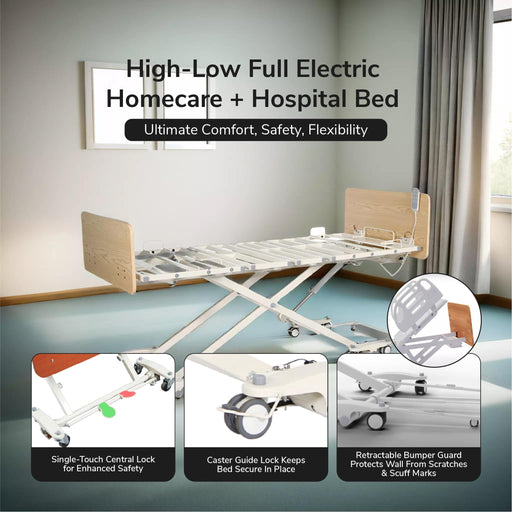
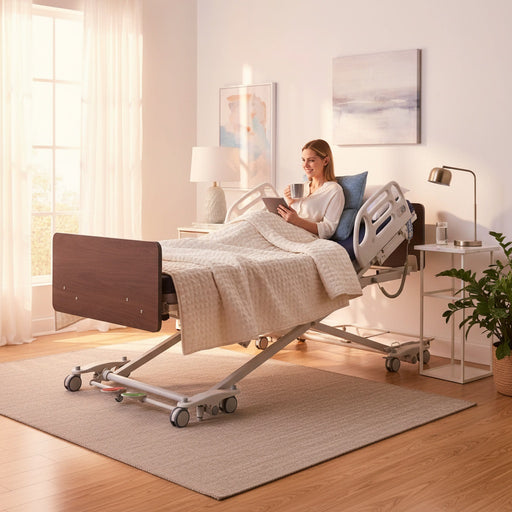
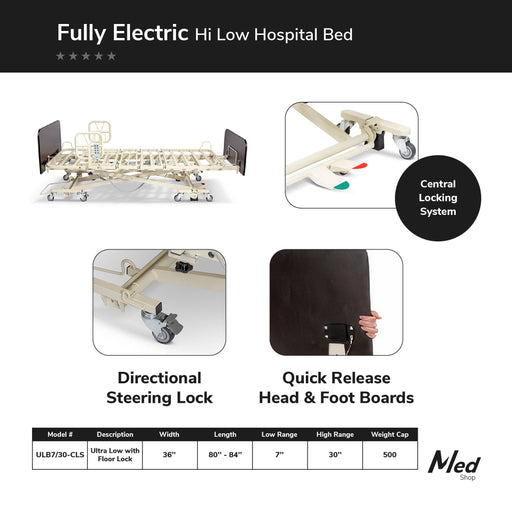
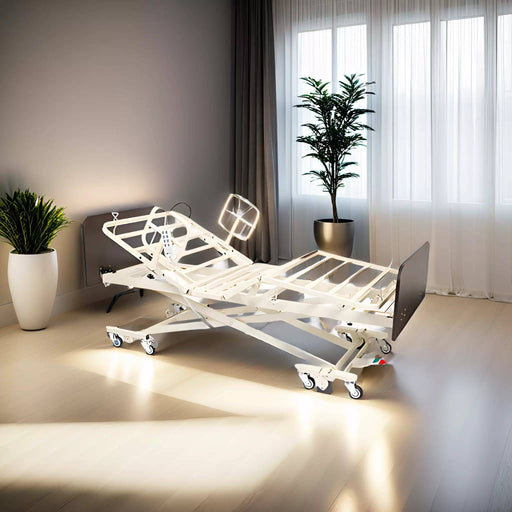


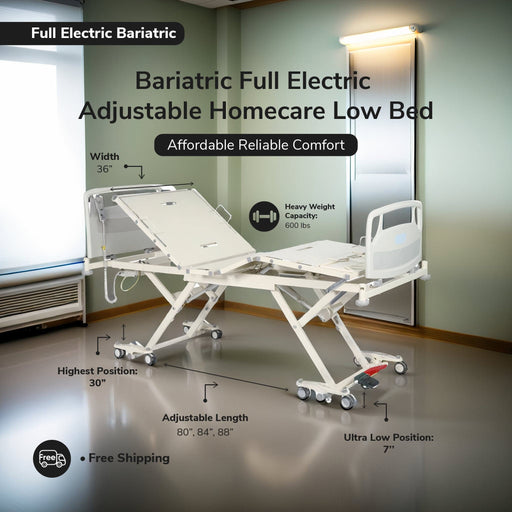
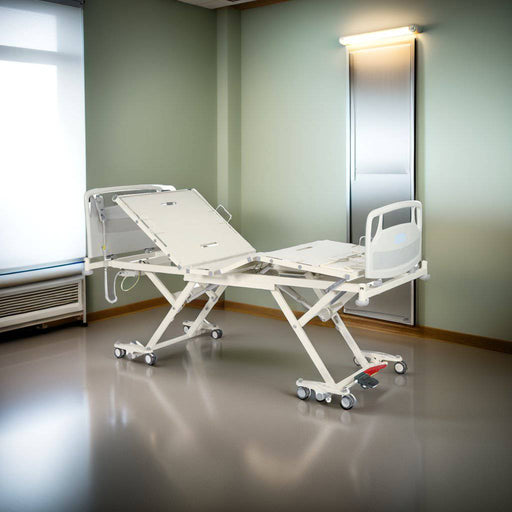
Leave a comment